The Hirsch Pirkei Avos

For those who are unfamiliar, Rabbi Samson Raphael Hirsch, of blessed memory, was a nineteenth century German rabbi who fought to maintain that Torah observance was not incompatible with a modern life. At the same time, however, he adamantly opposed the compromises being introduced by the rise of both Reform and Conservative Judaism during his lifetime. He is known as the father of “neo-Orthodoxy.” According to the Jewish Virtual Library, Hirsch had a unique relationship with Pirkei Avot in that it both inspired and informed him for his revolutionary approach to Torah study and practice.
Hirsch's understanding of modern Judaism became known as "Torah im Derekh Eretz," after the verse in Pirke Avot (2:2) that "Torah is good together with derekh eretz." In the context of the Mishna, derekh eretz means an occupation but Hirsch expanded its meaning to include full engagement with western culture, while maintaining adherence to Jewish law.
Knowing of this inspiration, it is not surprising that Hirsch dedicated time to write his own commentary on Pirkei Avot. Until now, however, this commentary has not been available to us in English. Thankfully, it has recently been translated and made available through Feldheim Publishers.
At only 177 pages, Rabbi Hirsch’s ability to communicate clearly and succinctly in as few words as necessary is clearly seen in this brief offering. His keen insight and acute observation draw the reader into the text as quickly as possible without a lot of rambling. For those who are not familiar with Pirkei Avot, this text might be a great starter, as it is written in small segments which are easily digestible.
However, this commentary is not without challenges. While the commentary is clear and easy to understand, the editors have chosen to leave the Hebrew words and phrases within his commentary both unvocalized (without vowels) and largely untranslated. This can be a difficulty for readers who are not conversant with Hebrew and could take some deciphering to understand his comments. Even the introductions to the specific portion of the mishnah (saying) that is being commented on is in unvocalized Hebrew. For instance, when he begins his commentary on the first mishnah, the reference is to “מסיני.” If one can read Hebrew, it would quickly be understood that he is commenting on the phrase “from Sinai,” a single word in Hebrew. Those who do not understand Hebrew would have to make an educated guess as to the word or phrase upon which he is commenting.
Overall, this is an excellent work. It is one I would happily recommend for anyone, whether they have a working knowledge of Hebrew or not. While they may not understand everything, they will gain enough insights to compensate for what they miss through lack of translation.








